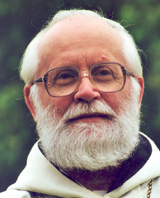 |
|
||
|
|
|||
|
September 14, 2008
Assisi, Italy,
General Chapter OCSO 2008
Homily for the Feast of the
Holy Cross
A
scandal for the Jews, a folly for the Pagans, the Cross is for those who
believe, the symbol and source of salvation.
In
the first centuries, Christians did not put the figure of Christ on the cross, but
decorated it with precious stones. Later, the image of the Son of Man appeared, Son of Man who – according
to the beautiful ambiguity which this expression contains in the New Testament
– represents both Christ himself, and all with whom he has chosen to be
identified.
It
suffices to close our eyes and contemplate the cross, to see all the rivers of
blood flowing in all directions to make our lands fruitful.
It was the blood of
It was the blood of the
Europeans who brought the faith to other continents of
The
Cross is also the symbol of the courage and the holy folly of those who, all
through the centuries, have brought the Cistercian tradition to other lands and
other continents, carrying with them a humble cross of wood.
At
the time of the French Revolution, when so many persons in France were shedding
their blood for the faith, a small group of monks, under the direction of Dom
Augustine – as strange in character as in name - left La Trappe and France,
with a foundation cross that they planted in numerous countries both in Europe
and in America, before returning to France after the Revolution to replant it
in many monasteries.
A
real folly. And from this folly were
born almost all the monasteries of the Strict Observance, which we represent
here, in these Chapters.
In
1892, scattered pieces of this Strict Observance reunited to form one Order
which, a few decades later, left in every directions: for Africa, Latin
America, Asia, and elsewhere, always with a foundation cross as emblem.
To
bring the faith or the monastic life into foreign lands is not to bring them
the wisdom of our own lands or of our founding communities, but rather, the
folly of the Cross. In the same way, the
inculturation of local Churches and of monasticism consists not in adapting the
Gospel and monasticism to local customs, but to make sure that local cultures
allow themselves to be transformed and purified through the folly of the Cross.
Let
us adore this cross which is folly for the pagans – these pagans that we have
never completely stopped being. May this
cross be for each of us the source of salvation.
Armand Veilleux
|
|
||
|
|
|||
